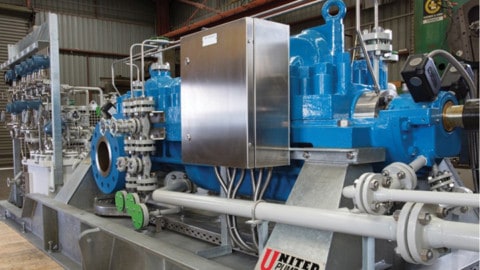By Heinz P. Bloch, PE, Process Machinery Consulting
In part two in this series on upgrading process pump power frames, Heinz P. Bloch provides more pointers on how to obtain improved power ends.
DN-number defines oil level preferences in bearing housings
Perhaps half of the world’s oil-lubricated industrial pump bearing housings are furnished with inexpensive oil rings, also called ‘slinger rings’, that lift the lubricant from an oil sump (Figures 1 and 2).
In some applications, oil rings or small discs that just barely contact the oil at its level surface are helpful for maintaining the oil volume more uniformly mixed, ie. to prevent temperature stratification.
Stratification is a term that describes hot oil floating upward and staying near the top of the oil sump. Conversely, the cooler oil has greater density and tends to sink down to the bottom of a bearing housing.

Figure 1: Bearing housing with two oil rings (“slinger rings”) and oil passages (“galleries”) allowing oil to flow into the bearings.

Figure 2: Oil ring dimensional ratios and typical immersion depth.
Typically, the loose oil rings shown in Figure 1 and 2 are immersed about 3/8th inch (~10-11mm) for the purpose of spraying oil into the bearings¹²³. Oil rings are not required in pumps with low-to-moderate shaft peripheral velocities.
In these typical “without oil ring” designs, the oil level must reach to the center of the lowermost bearing element – usually a bearing ball. Higher shaft velocities are defined next.
Bearing and shaft velocity constraints
Bearing peripheral velocities are more conveniently expressed as DN-values, the product of multiplying inches of shaft diameter times by shaft rpm. For example, a 70mm (~2.75 inch) bearing operating with a shaft turning at 1,800 rpm would have a DN-value of 4,960; values below 6,000 are somewhat arbitrarily considered low-to-moderate DN numbers.
In designs with DN <6,000 (conservative) and possibly reaching (but not exceeding) a DN as high as 8,000, both housing geometry and constant level lubricator height settings are generally selected to allow lubricating oil to reach the centre of the lowermost bearing ball or rolling element.
Keep the numbers 6,000 to 8,000 in mind; they represent an interesting DN parameter¹²³. Satisfactory oil ring functioning is obtained in the range of from 2,000-2,500ft/minute shaft surface velocity, which can be expressed in terms of diameter and rpm.
Some bearing manufacturers (and also machine designers) recalculate to show the acceptable range of surface velocities that comply in the metric system. Bearing producers often use a dN expression, with ‘d’ generally designating a mean, or average, diameter (mm) of rolling element bearings.
The mean, or average, dN would equate to [½] x [OD+ID] x rpm and we have seen dN-range stipulations from 300,000 to maximum values of 500,000. As an example, a bearing with a 100mm bore, an OD of 180mm, and a shaft operating at 3,000 rpm would have dN = ½ [100 + 180] X 3,000 = 420,000.
The shaft surface velocity would be 100 x 3.14 x 3,000 = 942,000mm/min or 3090ft/min. Seeking reasonable agreement with the numbers given above, we looked up a 400mm (~15.7-inch shaft diameter) double-row spherical roller bearing used in a large mixeragitator drive.
With grease lubrication, the manufacturer allows a maximum speed of 380 rpm; its DN would thus be (15.7) x (380) = 6,000. With oil lubrication, the manufacturer advises a maximum speed of 480 rpm. Its DN would equal 7,540. The same bearing’s outside diameter is 650mm, its metric ’d’ is (650 + 400)/2 = 1,050/2 = 525mm.
Therefore, dN for grease would be (525) x (380) = 199,500; dN for oil = (525) x 480 = 252,000. Our conclusion would be that this shaft and its bearing system approach and possibly even exceed the upper limits of shaft surface velocity. The equipment manufacturer tested the machine for a few hours at close to best achievable conditions of oil viscosity, shaft horizontality, ring immersion, etc.
He acted in good faith when he shipped the machine to your plant. However, operating conditions at your plant are far from ideal, and the machine will likely experience an above-average number of failures.
Perhaps it would have been prudent to upgrade the lubrication system at the specification stage, or to do so now, by identifying and scheduling a combined repair and upgrade task³.
Oil levels in bearing housings with different size bearings
Reaching the centre-of-rolling element oil level requirement would be difficult to achieve if the shaft support bearings had different diameters. In that case, one uses oil rings, as shown in Figures 1 and 2. Oil rings are also used for higher speeds, in situations where oil reaching the centre of the lowermost bearing is no longer reliable.
Unreliable lubrication would result if the frictional energy of bearing elements racing through a pool of oil would be high enough to create excessive heat. However, serious concerns about the reliability risks associated with oil rings have prompted reliability professionals to seek more reliable means of lubricant application.
Some have elected to apply the lubricant by one of several possible pressure-developing pump-around means¹³. Although originally designed for pressurising the space between dual mechanical seals, these units are well suited for bearing lubrication. Other thoughtful remedies and upgrades from oil rings include flinger disc retrofits or small oil mist units¹²³.
Experience checks are needed for small oil mist units and the manufacturer’s operating procedures should be consulted. Recall that with oil levels in bearing housings reaching the centre of the lowermost bearing ball while allowing DN values above 8,000, potentially excessive friction-induced temperatures are likely resulting.
Experiencing such temperatures led to the decision to lower the oil levels in many of the larger API-compliant pumps which operate at 3,000 and 3,600 rpm. In these, oil levels are customarily set well below the periphery of even the lowermost bearing ball.
Because oil is then no longer flooding a portion of the lowermost part of the bearing, mechanical means must be employed to feed, lift, spray, or splash the lubricant into the pump bearings. Also, whenever high DN or dN values rule out letting lubricating oil reach the centre of the lowermost bearing ball or rolling element, oil rings are often the (initially, but not ultimately) least expensive means of feeding oil into the bearings.
Oil rings have serious limitations
We have earlier alluded to oil rings (sometimes called slinger rings) having serious limitations, and some of these are either little known or not well publicised. Oil ring instability (‘wobbling’) is not a new phenomenon. To ensure proper operation, surface velocity limits around 3,500 to 4,000 fpm (~18-20m/s) with water cooling are often cited².
Such cooling simply implies the need for maintaining constant oil viscosity by closely controlling oil temperature. With mineral oils and without water cooling of the lubricant, we are asked to stay well inside the stable limit for oil rings and to not exceed peripheral velocities of 2,000 to 2,500 fpm, about 10-13m/s³.
More liberal numbers are feasible with synthetic lubricants. Another source of information, a major multi-national corporation’s ‘Lube Marketing Course’ text, suggests a DN value of 6,000 as the threshold of instability for oil rings.
As a precautionary rule, both authoritative texts warn that oil rings in field situations tend to become unstable whenever DN, the product of shaft diameter (inches) and speed (rpm), enters the region from 6,000 to perhaps 8,000; we might reserve 8,000 to a perfect test stand-like installation and assume that 6,000 represents the realistic field installation.
A two-inch shaft at 3,600 rpm would have a DN value of 7,200; it would thus operate in the risky or instability-prone zone. In comparison, equipment with a three-inch shaft operating at 1,800 rpm (DN = 5,400) might utilise oil rings without undue risk of instability¹².
As just one more example, a nominally three-inch diameter (actual bearing bore = 75mm) shaft at 3,600 rpm would have a DN = 10,800; it would definitely operate in the risky region. The surface velocity of this 75mm shaft at 3,600 rpm would be (πD/12)(3,600) = 2,780 fpm (~14.2m/s).
We must distinguish between situations with closely controlled (optimum) oil viscosity where the risky zone starts at 3,500 fpm, versus less well-controlled oil viscosity and immersion, where the risky zone starts at 2,000 fpm³. Again, synthetic lubricants are safer and have extended operating zones.
Experience helps, and no experimentation is needed if you capture solid input from lube manufacturers with an experienced application engineering staff¹.
About the author:
Heinz P. Bloch resides in Montgomery, Texas. His professional career commenced in 1962 and included long-term assignments as Exxon Chemical’s Regional Machinery Specialist for the United States. He has authored or co-written over 800 publications, among them 24 comprehensive books on practical machinery management, failure analysis, failure avoidance, compressors, steam turbines, pumps, oil mist lubrication and optimised lubrication for industry.
Mr. Bloch holds B.S. and M.S. degrees (cum laude) in Mechanical Engineering. He is an ASME Life Fellow and was awarded life-time registration as a Professional Engineer in New Jersey. He is one of ten inaugural inductees into NCE’s Hall of Fame, which honors its most distinguished alumni.

















